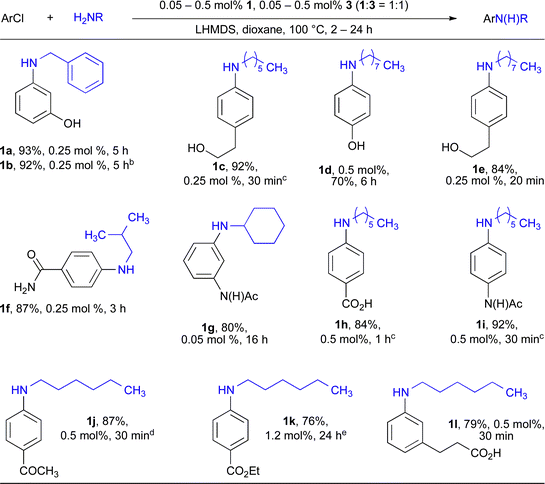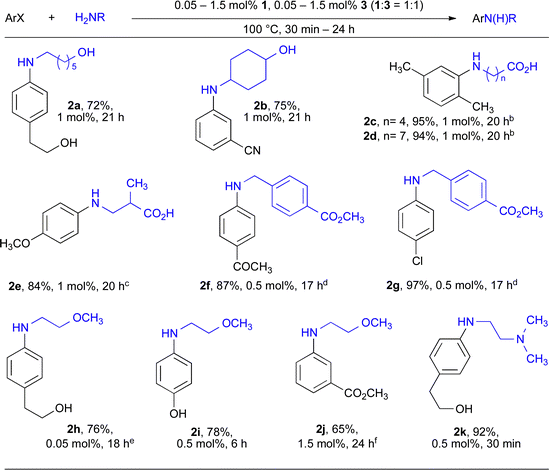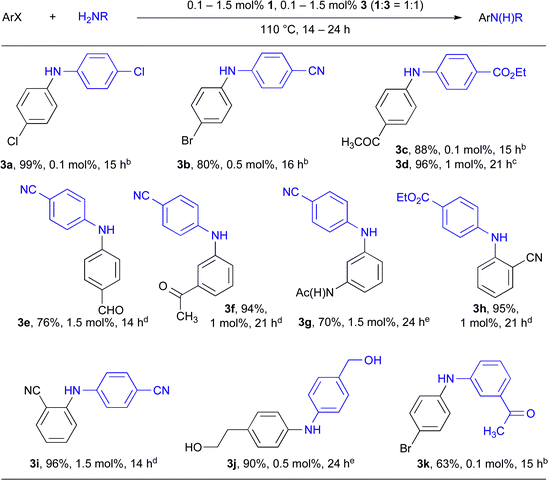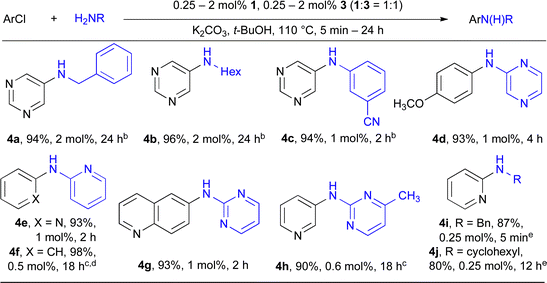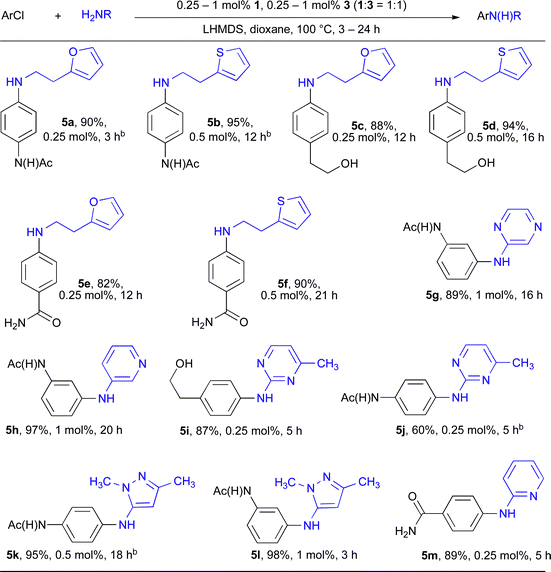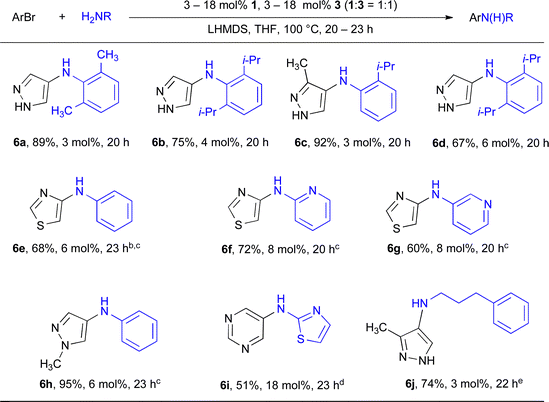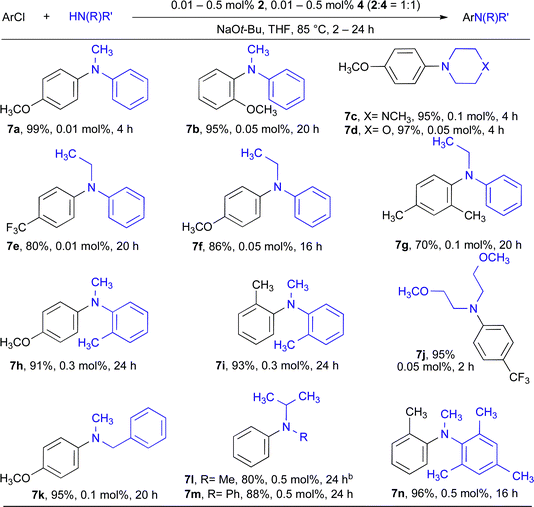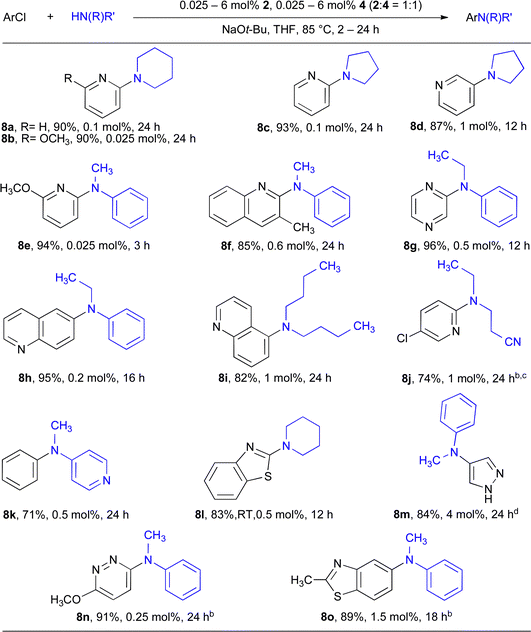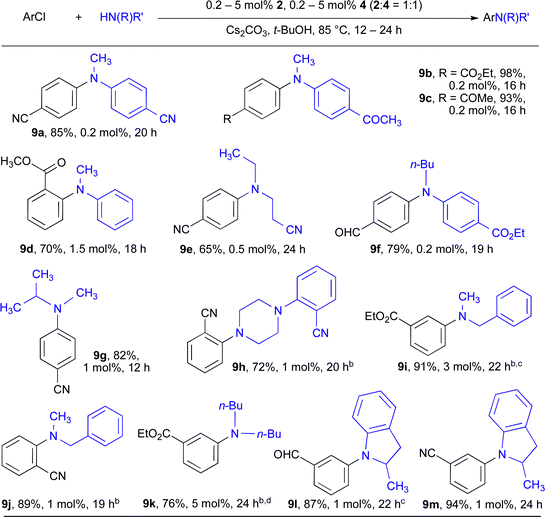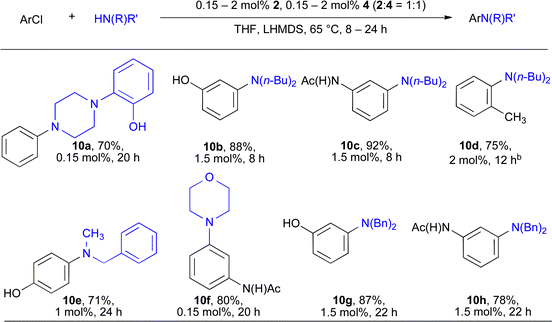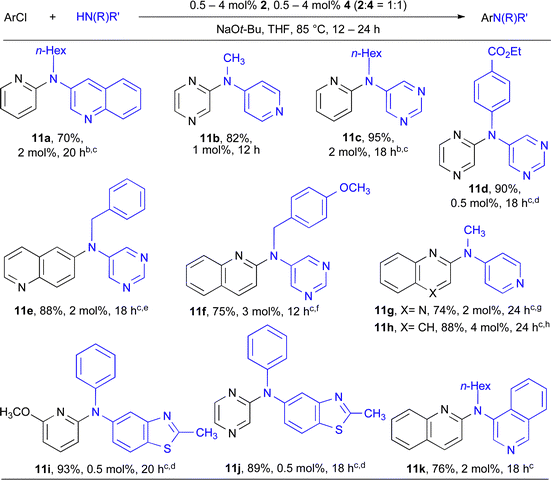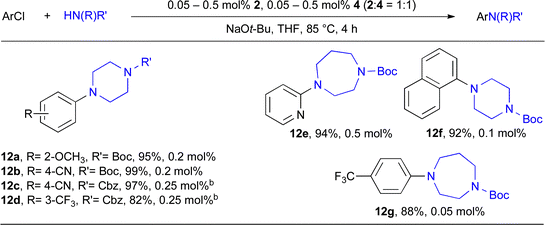Palladium-catalyzed coupling of functionalized primary and secondary amines with aryl and heteroaryl halides: two ligands suffice in most cases†
Debabrata
Maiti
,
Brett P.
Fors
,
Jaclyn L.
Henderson
,
Yoshinori
Nakamura
and
Stephen L.
Buchwald
*
Department of Chemistry, Massachusetts Institute of Technology, 77 Massachusetts Avenue, Cambridge Massachusetts, 02139, USA. E-mail: sbuchwal@mit.edu; Fax: +1-617-253-3297; Tel: +1-617-253-1885
First published on 9th September 2010
Abstract
We report our studies on the use of two catalyst systems, based on the ligands BrettPhos and RuPhos, which provide the widest scope for Pd-catalyzed C–N cross-coupling reactions to date. Often low catalyst loadings and short reaction times can be used with functionalized aryl and heteroaryl coupling partners. The reactions are highly robust and can be set up and performed without the use of a glovebox. These catalysts should find wide application in the synthesis of complex molecules including pharmaceuticals, natural products and functional materials.
1. Introduction
The Pd-catalyzed amination of aryl halides has become a valuable tool in industrial and academic research for the synthesis of substituted anilines.1–7 Such aromatic amines appear frequently in biologically active molecules,8 including a number of pharmaceuticals currently on the market, as well as in materials with useful physical properties.9–12 This cross-coupling methodology allows the conceptually simple, yet powerful, disconnection of an aromatic amine to an aryl halide or pseudo halide and a nitrogen nucleophile. The development of these Pd-catalyzed methods has been influential in the design of synthetic routes to novel pharmaceuticals, increasing both the efficiency of synthesis and the speed with which analogues for biological assay may be accessed. As a result, since the discovery13–15 of this process in 1995 there has been great interest in this area from numerous groups.1,7,16–25 Recently, significant improvements in substrate scope and catalyst loadings have been realized.2,26–32 Unfortunately, this process is yet to approach generality and the goal of being able to couple any nitrogen nucleophile with any aryl or heteroaryl halide is far from accomplished.In a notable recent contribution, Hartwig showed that palladium complexes generated from the Josiphos ligand CyPF-tBu are efficient catalysts for the coupling of aryl halides with primary aliphatic amines and primary anilines.26–28 These authors focused on the coupling of heteroaryl halides or functionalized aryl halides with simple amines; only a handful of examples of the coupling of heteroaryl amines with heteroaryl halides were presented and these required higher Pd loadings. In a typical synthetic application, however, both the nucleophilic and electrophilic components are functionalized. It is therefore an important goal to address such substrate combinations at lower catalyst loadings. The ability to use relatively low catalyst loadings is most salient on process development and manufacturing scales in order to reduce the cost of the catalyst and ease the removal of Pd residues from the product. Unfortunately, despite the recent improvements in the ability to perform Pd-catalyzed cross-coupling reactions at lower catalyst loadings, the beneficial effects are significantly mitigated on the manufacturing scale by the prolonged reaction times (typically 24–48 h). On these larger scales the cost of materials (reagents, catalysts, solvent, starting materials) usually contributes only 20–45% of the overall cost.33 In this setting the conversion costs become dominant, hence throughput (including reactor residence time and resource intensity) makes a substantial contribution to the economic viability of a process. For these reactions to become more industrially relevant, both low catalyst loadings and short reaction times should be attained.
Furthermore, the excellent mono- to diarylation selectivities observed when using Josiphos-type ligands stem from the poor ability of these metal complexes to catalyze the arylation of secondary amines.26 Indeed it was found that this transformation could be performed for only a small subset of secondary amines and at relatively high catalyst loading. In contrast, through the use of N-heterocyclic carbene ligands Nolan has shown that secondary amines can be coupled with unfunctionalized aryl halides at very low catalyst loadings; however, this method has been demonstrated only with simple amines such as morpholine and di-n-butylamine.2,29,31,32 A more general means to carry out this reaction at low catalyst loading would be of great significance.
In addition to these issues of catalyst loading, another concern is that a number of practically important nitrogen nucleophiles lack efficient catalytic systems for their arylation. Other than N-methylaniline, which is an especially easy substrate for most catalysts, acyclic N-alkyl anilines can be challenging.34 Very few studies have been devoted to this group of substrates and such as have been disclosed proceed in modest yields and with relatively high catalyst loadings. Furthermore, in the course of the synthesis of biologically-active molecules, the arylation of heteroaryl amines is often desired; such transformations have been described both by Cu-35,36 and Pd-catalyzed methods, however, systematic studies are limited.37–50
Similarly, there are also conspicuous deficiencies in the scope of suitable electrophiles for Pd-catalyzed amination. The amination of 6-membered ring heteroaryl halides bearing a single heteroatom is becoming increasingly well developed,51–54 however, other classes of heteroaryl halides have remained recalcitrant. The use of 5-membered ring heteroaryl halides has also been limited, especially those containing multiple heteroatoms.37–39,55
Herein, we report our studies on the use of two Pd precatalyst systems (Fig. 1), based on the ligands BrettPhos (1) and RuPhos (2), whose use have been shown to quantitatively form the active monoligated Pd(0) complex under the reaction conditions.56 These catalysts provide the widest scope for C–N cross-coupling reactions to date and go a significant way towards addressing the above-described limitations of Pd-catalyzed amination.
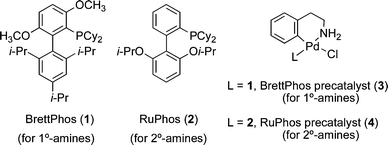 | ||
| Fig. 1 Ligands and precatalysts used in these studies for Pd-catalyzed C–N bond formation (1 and 3 are used for primary amines, 2 and 4 are used for secondary amines). | ||
The use of these catalysts promotes the cross-coupling of a wide range of primary and secondary alkyl amines and anilines with aryl halides and heteroaryl halides allowing the cross-coupling of complex substrate combinations, often at low catalyst loadings and in short reaction times.
2. Results and discussion
2.1.1. Catalytic amination of functionalized aryl chlorides with primary alkylamines
In a previous communication57 we showed that a catalyst system based on BrettPhos is highly active in the arylation of simple primary amines with a variety of simple aryl chlorides using 0.01–0.05 mol% Pd. Therefore, we were interested in exploring the scope of these systems in greater depth. Previously, we have shown that the use of LHMDS as base in conjunction with a Pd catalyst based on a dialkylbiaryl phosphine ligand allowed arylation of amines to be performed in the presence of a range of protic functional groups, including hydroxyls, amides and enolizable ketones.54,58 Hartwig has shown that unfunctionalized primary amines can be coupled with a range of functionalized aryl halides at catalyst loadings of 0.005–0.5 mol% Pd using a Josiphos-type ligand employing this base.26–28 Similarly, using 0.05–0.5 mol% Pd in conjunction with BrettPhos (Table 1) we were able to couple simple primary aliphatic amines with a range of functionalized aryl chlorides that contain phenolic OH (entries 1a, 1b and 1d) or aliphatic OH groups (entries 1c and 1e), amides (entries 1f, 1g and 1i), carboxylic acids (entries 1h and 1l), enolizable ketones (entry 1j) and esters (entry 1k). It is noteworthy that in the examples given in entries 1a, 1b, 1d, 1e, 1f and 1g the use of BrettPhos affords higher yields in shorter reaction times with equal or in some cases lower Pd loadings than previously reported.262.1.2. Functionalized aliphatic primary amines as the nucleophiles using a BrettPhos ligated Pd-catalyst
Despite the outstanding results described with unfunctionalized primary amines, no examples of similar reactions with functionalized primary amines were described. We thus decided to ascertain whether 3 could be used with such substrates. Indeed we found that it was also possible to couple functionalized primary amines with functionalized aryl chlorides (Table 2). Unprotected non-α-amino acids can be employed successfully under these conditions (entries 2c–2e). These substrates have rarely been employed in Pd-catalyzed amination reactions,59 despite the utility of N-aryl amino acid products. These methods present a complementary approach to the Cu-catalyzed arylation of amino acids, which are effective only for aryl bromides and iodides.60–62 The ability to use 2-chloro-p-xylene (entries 2c and 2d) is also important, as ortho-substituted aryl halides are often challenging substrates for Cu-catalyzed amination reactions. We have recently shown that 3 presents an effective system for the Pd-catalyzed amination of aryl iodides.63 Not surprisingly, under the reaction conditions reported here it was possible to effect the amination of 4-chloroiodobenzene with complete selectivity for coupling of the aryl iodide (entry 2g). Notably, functionalized coupling partners also produce the desired C–N coupling product in good to excellent yield (entries 2a, 2b, 2f–2k).A BrettPhos-based catalyst also proved useful in the N-arylation of primary anilines. Although a number of Pd-based catalyst systems have been disclosed for this transformation, these systems have typically not been challenged with the type of functionalized substrates that are often encountered in practical applications. In order to accommodate the greatest range of functional groups, the use of weak inorganic bases is often necessary. With a system based on 1, it was possible to perform coupling reactions of functionalized aryl iodides with functionalized anilines (Table 3) at catalyst levels as low as 0.1 mol% Pd.63 To our knowledge these are the most efficient coupling reactions reported that employ a weak (carbonate or phosphate) base. In order to utilize substrates bearing protic functional groups, LHMDS was employed and its use proved successful (entries 3g and 3j). It was possible to achieve the selective amination of aryl iodides in the presence of both aryl chlorides (entry 3a) and bromides (entries 3b and 3k), thus generating products suitable for further functionalization.
2.1.3. Synthesis of heteroaryl secondary amines
The coupling of heteroaryl halides is typically more challenging than that of aryl halides. A number of hypotheses have been proposed to explain this phenomenon.28,34,55,64 These substrates not only present an academic challenge, but are arguably of the highest importance in industrial settings. For example, the majority of applications of Pd-catalyzed amination in pharmaceutical research make use of heteroaryl halides as substrates. These factors have prompted a great deal of research into the utilization of these substrates in C–N cross-coupling reactions.1 Some success in developing catalyst systems that allow the amination of heteroaryl halides at relatively low catalyst loadings has been reported.26–30 However, these studies have been largely limited to 6-membered ring heterohalides. Further, these reactions have generally employed strong bases such as MOt-Bu (M = Na, K) or LHMDS, which limit the functional groups that can be tolerated.When LHMDS was used as the base, we could couple furan- (entries 5a, 5c and 5e) and thiophene- (entries 5b, 5d and 5f) containing aliphatic amines with aryl chlorides bearing functional groups with active protons. Also, 2-aminopyridine was successfully combined with 4-chlorobenzamide in 89% yield using only 0.25 mol% Pd in 5 h (entry 5m).
2.1.4. Pd-catalyzed cross-coupling reactions involving 5-membered heterocycles with multiple heteroatoms
Five-membered heteroaryl halides have been problematic substrates in Pd-catalyzed C–N cross-coupling reactions. It has been demonstrated that reductive elimination of the corresponding Pd(II) amido complexes (generated from secondary amine) to form the heteroaryl amines is slow and low yielding with dppf as the supporting ligand.53 More recently we have disclosed that catalysts based on 2 and SPhos could effectively couple chlorothiophenes, as well as 2-chlorobenzothiazoles, with primary and secondary amines in high yields.54 Five-membered ring heteroaryl halides containing multiple heteroatoms are especially challenging. Systematic studies of Pd-catalyzed amination of this class of substrates have only employed benzofused 5-membered heteroaryl halides. Furthermore, all previous examples of this class of transformation have used secondary amines; no examples with primary amines have been reported.51,54 Therefore, we investigated the use of 3 for the coupling of 5-membered heterocycles with multiple heteroatoms with primary amines, and in particular, with anilines (Table 6).The use of 3 in combination with LHMDS as the base allowed the amination of substituted halopyrazoles (entries 6a–6d, 6j) in good yields. Unfortunately, relatively high Pd loadings were required. When using LHMDS as base it was not necessary to use a protecting group for the heterocyclic NH (Table 6), in accord with our previous findings for the amination of haloindoles.54 We were particularly interested to examine the reaction of 5-membered ring heteroaryl halides with heteroaryl amines, as this difficult substrate combination is frequently encountered in the synthesis of biologically active molecules.40–50 Xantphos has received the most use for the cross-coupling of 5-membered heteroaryl amines bearing multiple heteroatoms;37–41 although, in some circumstances other ligands have been employed to give the desired product in moderate yields.44–46,65 Unfortunately, these reactions exploiting Xantphos have been largely limited to activated aryl bromides; electron neutral aryl bromides have been noted as having a narrower substrate scope and typically benzofused amines must be employed. By employing 1 as the supporting ligand, however, it was possible to effect the coupling of pyridyl amines with 4-bromothiazole (entries 6f and 6g), as well as 2-aminothiazole with 5-bromopyrimidine (entry 6i). Certain other heteroaryl halides remain recalcitrant; we were not able to obtain any coupling product from the reaction of bromoisoxazoles, bromoimidazoles or 3- or 5-halopyrazoles.
2.2.1. Scope of the amination of aryl chlorides with secondary amines
To date little success in the cross-coupling of secondary amines with aryl chlorides at low catalyst loadings (<0.5 mol% Pd) has been obtained. For the coupling of acyclic secondary aliphatic amines, Nolan reported two examples of the arylation of di-n-butylamine at 0.01 mol% Pd using an NHC carbene ligand.31 The use of cyclic secondary amines is also rare; Beller reported a single example of the cross-coupling of piperidine at 0.1 mol% Pd of an activated aryl chloride66 and Hartwig reported two examples with morpholine,26 one at 0.1 mol% Pd and the other at 0.05 mol% Pd (although with reaction times of 48 h). For the coupling of N-substituted anilines at low Pd loadings, Beller has reported a handful of examples for the arylation of N-methylaniline with aryl chlorides at 0.01 mol% Pd.67,68 We have previously demonstrated that the use of the dialkylbiaryl phosphine ligand RuPhos permits the arylation of a range of secondary amines with aryl iodides at low catalyst loadings (0.01–0.1 mol% Pd).63 We, therefore, elected to study the scope of this system in the amination of aryl chlorides (Table 7). The combination of NaOt-Bu in THF proved efficient for these reactions. Both morpholine and N′-methylpiperazine underwent arylation with unactivated aryl chlorides at 0.05 mol% Pd (entries 7c and 7d). This catalyst system was also suitable for the cross-coupling of acyclic secondary amines at 0.05 mol% Pd (entry 7j). When using N-methylaniline, arylation of 4-chloroanisole could be performed at 0.01 mol% Pd (entry 7a). Although these are encouraging results, we were interested in investigating more challenging substrate combinations.34 It was found that larger N-substituents present a greater challenge; the reactions of N-ethyl-, N-benzyl- and N-isopropylanilines progressively required higher catalysts loadings. The coupling of N-methylanilines bearing substituents at the 2-position could also be achieved by increasing the catalyst loading to 0.3 mol% Pd (entries 7h and 7i). ortho-Substituted aryl chlorides could also be employed, although once again this necessitated a slight increase in catalyst loading (compare 7a and 7b). Indeed it was even possible to bring about the coupling of ortho-substituted anilines with ortho-substituted aryl chlorides (entry 7i). Notably, by increasing the catalyst loading to 0.5 mol% Pd, the coupling of N-methyl-2,4,6-trimethylaniline with 2-chlorotoluene could be effected in an excellent yield (entry 7n).2.2.2. Scope of amination reactions of heteroaryl chlorides with secondary amines
We proceeded to investigate the coupling of secondary amines with heteroaryl chlorides (Table 8). Of the heteroaryl chlorides examined, 2-chloropyridine proved to be the least challenging – cyclic secondary amines could be coupled with this substrate with 0.025–0.1 mol% Pd (entries 8a–8c and 8e). The cross-coupling of 3-chloropyridine proved more difficult, requiring 1 mol% Pd to achieve efficient coupling with pyrrolidine (entry 8d). The use of Cs2CO3 allowed the coupling of a chloropyridine to be performed in the presence of a nitrile (entry 8j) or of a 2-methylbenzothiazole (entry 8o). The ability to couple acyclic aliphatic amines with heteroaryl chlorides is especially noteworthy (entry 8i). Furthermore, employing LHMDS as base facilitated the coupling of an unprotected haloheterocycle containing a free NH group such as 4-chloropyrazole (entry 8m) with N-methylaniline. Although the catalyst loadings are high (4–6 mol% Pd) and N-methylaniline is among the easiest of nucleophiles to use in such reactions, such electrophiles have not previously been employed in Pd-catalyzed C–N cross-coupling reactions. It appears that a general trend for the efficiency of the coupling of secondary heteroaryl chlorides with secondary amines can be discerned: 5- and 6-membered secondary cyclic alkylamines (e.g., pyrrolidine, piperidine) ∼ N-methylanilines > N-ethylanilines > N-methylbenzylamine > N-methyl-o-tolylamine > secondary acyclic alkylamines.342.2.3. Generation of functionalized tertiary amines
The use of Cs2CO3 as a base in Pd-catalyzed amination processes allows a wider range of electrophilic functional groups to be incorporated into the substrates than if NaOt-Bu is employed (Table 9). Unfortunately, reaction rates are typically lower with a weaker base, necessitating higher catalyst loadings. There are no reported examples of Cs2CO3 as the base in the arylation of secondary amines with aryl chlorides employing <0.5 mol% Pd. By the use of a RuPhos-based catalyst system it was possible to effect the cross-coupling of a number of substrate combinations bearing electrophilic functional groups, such as esters (entries 9b and 9f), nitriles (entry 9a) and enolizable ketones (entry 9c), at only 0.2 mol% Pd loading. Aliphatic amines require slightly higher catalyst loadings (entries 9e, 9h–9m) than anilines. For example, the arylation of N-methylisopropylamine can also be achieved using Cs2CO3 as the base (entry 9g).As in the case of primary amines, the use of LHMDS as base allows the incorporation of protic functional groups into the reactants (Table 10). Under these conditions cyclic secondary amines could be coupled at 0.15 mol% Pd (entry 10a); however, acyclic secondary amines such as di-n-butylamine (entries 10b and 10c) typically required higher catalyst loadings (1.5 mol%). For the coupling of these substrates with ortho-substituted aryl chlorides SPhos proved to be a superior ligand. For example, di-n-butylamine was combined with 2-chlorotoluene in only 12 h with a catalyst loading of 2 mol% Pd (entry 10d).
2.2.4. Catalytic amination reactions of heteroaryl chlorides and heteroaryl secondary amines
Despite advances in the Pd-catalyzed amination reactions of heteroaryl chlorides with primary amines, the use of secondary amines has presented challenges and is less studied. Further, reports of the coupling of secondary heteroaryl amines with heteroaryl chlorides are rare.69,70 We were, therefore, interested to investigate the feasibility of this transformation due to the importance of the resulting products in pharmaceuticals and the appearance of heteroaryl triarylamines in materials science applications.11 In the presence of a RuPhos-based catalyst this challenging transformation could be achieved for a number of substrate combinations (Table 11), including pyridyl (entries 11a, 11c and 11i), pyrazinyl (entries 11b, 11d and 11j), quinoxinyl (entry 11g) and quinolyl chlorides (entries 11e, 11f, 11h and 11k). Despite the relatively high catalyst loadings (0.5–4 mol% Pd) required, the ability to achieve the cross-coupling of these substrates in such high yield is of significant importance. Moreover, it was also possible to use the combination of Cs2CO3/t-BuOH to effect these transformations (entries 11d, 11i and 11j), allowing even greater functional group tolerance. Using these conditions the somewhat acidic 2-methyl benzothiazole moiety (entries 11i and 11j) was not problematic. We note that reduction of the aryl halides could not be suppressed completely in some cases (entries 11e and 11f); however, the products were still isolated in good to excellent yields.2.2.5. Catalytic amination of (mono) Boc and Cbz protected secondary diamines
N-Aryl piperazines appear frequently in biologically active molecules,8 but the Pd-catalyzed arylation of these substrates can be more challenging than other cyclic amines.71 There have been only a limited number of studies of the arylation of piperazines with aryl chlorides and these have typically used relatively large amounts of catalyst (>1 mol% Pd) and have employed activated substrates as coupling partners.72,73 By using a RuPhos-based catalyst system, we were able to arylate Boc-protected piperazine with a range of aryl chlorides in good yields (Table 12, entries 12a, 12b and 12e–12g). Under the same conditions Cbz-protected piperazines gave lower yields for these reactions. However, by switching the base and solvent combination to K3PO4 in t-BuOH we are able to obtain the products of these reactions in improved yields (entries 12c and 12d).Synthesis of Gleevec®
Above, we have shown that catalysts based on 1 can successfully couple a range of heteroaryl substrates. We wanted to further highlight the utility of our system by applying it to the synthesis of an important biologically active molecule. Imatinib base (Gleevec®) is a small molecule protein kinase inhibitor that is used in the treatment of chronic myelogenous leukemia and was the first of a growing class of kinase inhibitors that specifically target various tumor cells.74–76 A key feature of many of this revolutionary class of drugs is the diarylamine subunit.42 This molecule also possesses a number of features typical of modern pharmaceutical agents, including multiple heteroatoms and electrophilic functional groups, as well as having high polarity.77 This, therefore, seemed to be an ideal target on which to test the applicability of a BrettPhos-based catalyst. A number of syntheses of imatinib have been previously reported,78–83 including approaches involving both Pd-78,83 and Cu-catalyzed82 cross-coupling. These, however were inefficient with respect to the reactivity of catalyst required and could not use aryl chloride substrates as coupling partners. For our approach to the synthesis of Gleevec®, we envisioned a C–N cross-coupling reaction between a 2-aminopyrimidine B and fragment A (Scheme 1). The 2-aminopyrimidine fragment can be made in a single step and is commercially available. The required aryl chloride coupling partner A was prepared in a 2-step, one pot procedure in 73% yield from commercially available precursors. The cross-coupling reaction between A and commercially available B proceeded efficiently in the presence of 2 mol% 3 to furnish imatinib base in 84% yield. The ability to perform this challenging cross-coupling reaction allows a very concise and efficient 2-pot synthesis of imatinib base.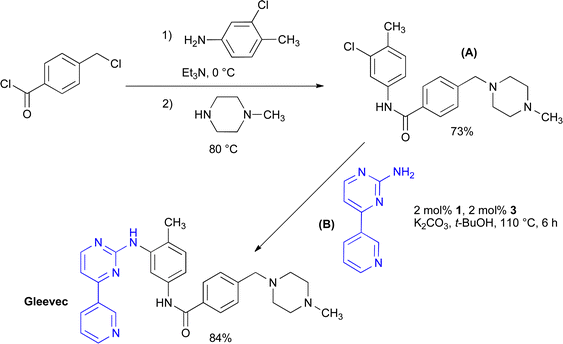 | ||
| Scheme 1 Synthesis of imatinib base. | ||
3. Conclusions
In summary, we have shown that a broad range of primary and secondary amines can be arylated with functionalized aryl and heteroaryl halides. Further, the examples described show that the presence of multiple heteroatoms in either (or both) coupling partners has little deleterious effect on the reaction. It is notable that despite the wide variety of coupling partners only two ligand systems are required, BrettPhos, 1, for primary amines and RuPhos, 2, for secondary amines. Often low catalyst loadings and short reaction times can be used and these results compare favorably with previously reported catalyst systems. The reactions are highly robust and can be set up and performed without the use of a glovebox. As a result of this unique combination of desirable features, we expect these catalysts to be widely employed in synthetic contexts where these characteristics are prerequisites for applicability, such as in the synthesis of pharmaceuticals, natural products and functional materials.Acknowledgements
This activity is supported by an educational donation provided by Amgen and by funds from the National Institutes of Health (Grant GM-58160). B.P.F. thanks Boehringer Ingelheim and The American Chemical Society for a fellowship. We are grateful to Dr David S. Surry for comments and help with this manuscript. The NMR instruments used for this study were furnished by funds from the National Science Foundation (CHE 9808061 and DBI 9729592).Notes and references
- D. S. Surry and S. L. Buchwald, Angew. Chem., Int. Ed., 2008, 47, 6338–6361 CrossRef CAS
.
- N. Marion and S. P. Nolan, Acc. Chem. Res., 2008, 41, 1440–1449 CrossRef CAS
.
- J. F. Hartwig, Acc. Chem. Res., 2008, 41, 1534–1544 CrossRef CAS
.
- S. Tasler, J. Mies and M. Langa, Adv. Synth. Catal., 2007, 349, 2286–2300 CrossRef CAS
.
- C. Torborg and M. Beller, Adv. Synth. Catal., 2009, 351, 3027–3043 CrossRef CAS
.
- S. L. Buchwald, C. Mauger, G. Mignani and U. Scholz, Adv. Synth. Catal., 2006, 348, 23–39 CrossRef CAS
.
- E. A. B. Kantchev, C. J. O'Brien and M. G. Organ, Angew. Chem., Int. Ed., 2007, 46, 2768–2813 CrossRef CAS
.
- D. A. Horton, G. T. Bourne and M. L. Smythe, Chem. Rev., 2003, 103, 893–930 CrossRef CAS
.
- R. Eelkema and H. L. Anderson, Macromolecules, 2008, 41, 9930–9933 CrossRef CAS
.
- Y. Kawabe, H. Ikeda, T. Sakai and K. Kawasaki, J. Mater. Chem., 1992, 2, 1025–1031 RSC
.
- Z. J. Ning and H. Tian, Chem. Commun., 2009, 5483–5495 RSC
.
- R. Lygaitis, V. Getautis and J. V. Grazulevicius, Chem. Soc. Rev., 2008, 37, 770–788 RSC
.
- A. S. Guram, R. A. Rennels and S. L. Buchwald, Angew. Chem., Int. Ed. Engl., 1995, 34, 1348–1350 CrossRef CAS
.
- J. P. Wolfe and S. L. Buchwald, J. Org. Chem., 1996, 61, 1133–1135 CrossRef CAS
.
- J. Louie and J. F. Hartwig, Tetrahedron Lett., 1995, 36, 3609–3612 CrossRef CAS
.
- J. P. Wolfe, S. Wagaw and S. L. Buchwald, J. Am. Chem. Soc., 1996, 118, 7215–7216 CrossRef CAS
.
- M. S. Driver and J. F. Hartwig, J. Am. Chem. Soc., 1996, 118, 7217–7218 CrossRef CAS
.
- Y. Guari, D. S. van Es, J. N. H. Reek, P. C. J. Kamer and P. van Leeuwen, Tetrahedron Lett., 1999, 40, 3789–3790 CrossRef CAS
.
- B. C. Hamann and J. F. Hartwig, J. Am. Chem. Soc., 1998, 120, 7369–7370 CrossRef CAS
.
- A. Ehrentraut, A. Zapf and M. Beller, J. Mol. Catal. A: Chem., 2002, 182–183, 515 CrossRef CAS
.
- L. L. Hill, L. R. Moore, R. C. Huang, R. Craciun, A. J. Vincent, D. A. Dixon, J. Chou, C. J. Woltermann and K. H. Shaughnessy, J. Org. Chem., 2006, 71, 5117–5125 CrossRef CAS
.
- M. Nishiyama, T. Yamamoto and Y. Koie, Tetrahedron Lett., 1998, 39, 617–620 CrossRef CAS
.
- N. Kataoka, Q. Shelby, J. P. Stambuli and J. F. Hartwig, J. Org. Chem., 2002, 67, 5553–5566 CrossRef CAS
.
- L. Ackermann, Synthesis, 2006, 1557–1571 CrossRef CAS
.
- S. Urgaonkar, J. H. Xu and J. G. Verkade, J. Org. Chem., 2003, 68, 8416–8423 CrossRef CAS
.
- Q. Shen, T. Ogata and J. F. Hartwig, J. Am. Chem. Soc., 2008, 130, 6586–6596 CrossRef CAS
.
- Q. L. Shen and J. F. Hartwig, Org. Lett., 2008, 10, 4109–4112 CrossRef CAS
.
- Q. L. Shen, S. Shekhar, J. P. Stambuli and J. F. Hartwig, Angew. Chem., Int. Ed., 2005, 44, 1371–1375 CrossRef CAS
.
- N. Marion, E. C. Ecarnot, O. Navarro, D. Amoroso, A. Bell and S. P. Nolan, J. Org. Chem., 2006, 71, 3816–3821 CrossRef CAS
.
- O. Navarro, N. Marion, J. G. Mei and S. P. Nolan, Chem.–Eur. J., 2006, 12, 5142–5148 CrossRef
.
- N. Marion, O. Navarro, J. G. Mei, E. D. Stevens, N. M. Scott and S. P. Nolan, J. Am. Chem. Soc., 2006, 128, 4101–4111 CrossRef CAS
.
- J. Broggi, H. Clavier and S. P. Nolan, Organometallics, 2008, 27, 5525–5531 CrossRef CAS
.
- T. Y. Zhang, Chem. Rev., 2006, 106, 2583–2595 CrossRef CAS
.
- A. R. Muci and S. L. Buchwald, Top. Curr. Chem., 2002, 219, 131–209
.
- Y. Liu, Y. Bai, J. Zhang, Y. Li, J. Jiao and X. Qi, Eur. J. Org. Chem., 2007, 6084–6088 CrossRef CAS
.
- H. Zhang, Q. Cai and D. Ma, J. Org. Chem., 2005, 70, 5164–5173 CrossRef CAS
.
- J. J. Yin, M. M. Zhao, M. A. Huffman and J. M. McNamara, Org. Lett., 2002, 4, 3481–3484 CrossRef CAS
.
- J. P. Schulte and S. R. Tweedie, Synlett, 2007, 2331–2336 CrossRef CAS
.
- R. Bonala, M. C. Torres, C. R. Iden and F. Johnson, Chem. Res. Toxicol., 2006, 19, 734–738 CrossRef CAS
.
- M. Zhao, J. J. Yin, M. A. Huffman and J. M. McNamara, Tetrahedron, 2006, 62, 1110–1115 CrossRef CAS
.
- Z. L. Shen, Y. M. Hong, X. F. He, W. M. Mo, B. X. Hu, N. Sun and X. Q. Hu, Org. Lett., 2010, 12, 552–555 CrossRef CAS
.
- A. Quintas-Cardama, H. Kantarjian and J. Cortes, Nat. Rev. Drug Discovery, 2007, 6, 834–848 CrossRef CAS
.
- C. B. Andersen, Y. Wan, J. W. Chang, B. Riggs, C. Lee, Y. Liu, F. Sessa, F. Villa, N. Kwiatkowski, M. Suzuki, L. Nallan, R. Heald, A. Musacchio and N. S. Gray, ACS Chem. Biol., 2008, 3, 180–192 CrossRef CAS
.
- E. Schoffers, P. D. Olsen and J. C. Means, Org. Lett., 2001, 3, 4221–4223 CrossRef CAS
.
- Z. W. Wang and C. J. Rizzo, Org. Lett., 2001, 3, 565–568 CrossRef CAS
.
- D. Bauer, D. A. Whittington, A. Coxon, J. Bready, S. P. Harriman, V. F. Patel, A. Polverino and J. C. Harmange, Bioorg. Med. Chem. Lett., 2008, 18, 4844–4848 CrossRef CAS
.
- M. Queiroz, A. Begouin, I. Ferreira, G. Kirsch, R. C. Calhelha, S. Barbosa and L. M. Estevinho, Eur. J. Org. Chem., 2004, 3679–3685 CrossRef CAS
.
- B. Vidal, A. Nueda, C. Esteve, T. Domenech, S. Benito, R. F. Reinoso, M. Pont, M. Calbet, R. Lopez, M. I. Cadavid, M. I. Loza, A. Cardenas, N. Godessart, J. Beleta, G. Warrellow and H. Ryder, J. Med. Chem., 2007, 50, 2732–2736 CrossRef CAS
.
- R. L. Knight, D. R. Allen, H. L. Birch, G. A. Chapman, F. C. Galvin, L. A. Jopling, C. J. Lock, J. W. G. Meissner, D. A. Owen, G. Raphy, R. J. Watson and S. C. Williams, Bioorg. Med. Chem. Lett., 2008, 18, 629–633 CrossRef CAS
.
- Y. P. Hong, G. J. Tanoury, H. S. Wilkinson, R. P. Bakale, S. A. Wald and C. H. Senanayake, Tetrahedron Lett., 1997, 38, 5607–5610 CrossRef CAS
.
- M. W. Hooper, M. Utsunomiya and J. F. Hartwig, J. Org. Chem., 2003, 68, 2861–2873 CrossRef CAS
.
- K. Ogawa, K. R. Radke, S. D. Rothstein and S. C. Rasmussen, J. Org. Chem., 2001, 66, 9067–9070 CrossRef CAS
.
- M. W. Hooper and J. F. Hartwig, Organometallics, 2003, 22, 3394–3403 CrossRef CAS
.
- M. D. Charles, P. Schultz and S. L. Buchwald, Org. Lett., 2005, 7, 3965–3968 CrossRef CAS
.
- K. W. Anderson, R. E. Tundel, T. Ikawa, R. A. Altman and S. L. Buchwald, Angew. Chem., Int. Ed., 2006, 45, 6523–6527 CrossRef CAS
.
- M. R. Biscoe, B. P. Fors and S. L. Buchwald, J. Am. Chem. Soc., 2008, 130, 6686–6687 CrossRef CAS
.
- B. P. Fors, D. A. Watson, M. R. Biscoe and S. L. Buchwald, J. Am. Chem. Soc., 2008, 130, 13552–13554 CrossRef CAS
.
- M. C. Harris, X. H. Huang and S. L. Buchwald, Org. Lett., 2002, 4, 2885–2888 CrossRef CAS
.
- W. S. Cheung, R. R. Calvo, B. A. Tounge, S. P. Zhang, D. R. Stone, M. R. Brandt, T. Hutchinson, C. M. Flores and M. R. Player, Bioorg. Med. Chem. Lett., 2008, 18, 4569–4572 CrossRef CAS
.
- D. W. Ma and Q. A. Cai, Acc. Chem. Res., 2008, 41, 1450–1460 CrossRef CAS
.
- D. W. Ma, Y. D. Zhang, J. C. Yao, S. H. Wu and F. G. Tao, J. Am. Chem. Soc., 1998, 120, 12459–12467 CrossRef CAS
.
- Z. Lu and R. J. Twieg, Tetrahedron Lett., 2005, 46, 2997–3001 CrossRef CAS
.
- B. P. Fors, N. R. Davis and S. L. Buchwald, J. Am. Chem. Soc., 2009, 131, 5766–5768 CrossRef CAS
.
- Q. L. Shen and J. F. Hartwig, J. Am. Chem. Soc., 2007, 129, 7734–7735 CrossRef CAS
.
- A. Baeza, C. Burgos, J. Alvarez-Builla and J. J. Vaquero, Tetrahedron Lett., 2007, 48, 2597–2601 CrossRef CAS
.
- M. Beller, T. H. Riermeier, C. P. Reisinger and W. A. Herrmann, Tetrahedron Lett., 1997, 38, 2073–2074 CrossRef CAS
.
- F. Rataboul, A. Zapf, R. Jackstell, S. Harkal, T. Riermeier, A. Monsees, U. Dingerdissen and M. Beller, Chem.–Eur. J., 2004, 10, 2983–2990 CrossRef CAS
.
- A. Tewari, M. Hein, A. Zapf and M. Beller, Tetrahedron, 2005, 61, 9705–9709 CrossRef CAS
.
- C. Bolm, J. C. Frison, J. Le Paih, C. Moessner and G. Raabe, J. Organomet. Chem., 2004, 689, 3767–3777 CrossRef CAS
.
- O. I. Patriciu, C. Pillard, A. L. Finaru, L. Sandulescu and G. Guillaumet, Synthesis, 2007, 3868–3876 CAS
.
- M. Hepperle, J. Eckert, D. Gala, L. Shen, C. A. Evans and A. Goodman, Tetrahedron Lett., 2002, 43, 3359–3363 CrossRef CAS
.
- D. Michalik, K. Kumar, A. Zapf, A. Tillack, M. Arlt, T. Heinrich and M. Beller, Tetrahedron Lett., 2004, 45, 2057–2061 CrossRef CAS
.
- U. Schon, J. Messinger, M. Buckendahl, M. S. Prabhu and A. Konda, Tetrahedron, 2009, 65, 8125–8131 CrossRef
.
- R. Capdeville, E. Buchdunger, J. Zimmermann and A. Matter, Nat. Rev. Drug Discovery, 2002, 1, 493–502 CrossRef CAS
.
- A. Arora and E. M. Scholar, J. Pharmacol. Exp. Ther., 2005, 315, 971–979 CrossRef CAS
.
- M. Deininger, E. Buchdunger and B. J. Druker, Blood, 2005, 105, 2640–2653 CrossRef CAS
.
- B. Nagar, W. G. Bornmann, P. Pellicena, T. Schindler, D. R. Veach, W. T. Miller, B. Clarkson and J. Kuriyan, Cancer Res., 2002, 62, 4236–4243 CAS
.
- O. Loiseleur, D. Kaufmann, S. Abel, H. M. Buerger, M. Meisenbach; B. Schmitz, G. Sedelmeier, WO Patent 03/066613, 2003.
- F. Leonetti, C. Capaldi and A. Carotti, Tetrahedron Lett., 2007, 48, 3455–3458 CrossRef CAS
.
- A. S. Ivanov and S. V. Shishkov, Monatsh. Chem., 2009, 140, 619–623 CrossRef CAS
.
- J. Zimmermann, E. Buchdunger, H. Mett, T. Meyer, N. B. Lydon and P. Traxler, Bioorg. Med. Chem. Lett., 1996, 6, 1221–1226 CrossRef CAS
.
- Y. F. Liu, C. L. Wang, Y. J. Bai, N. Han, J. P. Jiao and X. L. Qi, Org. Process Res. Dev., 2008, 12, 490–495 Search PubMed
.
- M. D. Hopkin, I. R. Baxendale and S. V. Ley, Chem. Commun., 2010, 46, 2450–2452 RSC
.
Footnote |
| † Electronic supplementary information (ESI) available: Synthetic methods and spectral data. See DOI: 10.1039/c0sc00330a |
| This journal is © The Royal Society of Chemistry 2011 |

